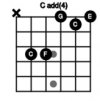Hmmm! Are you guys sure?

There is a method to my madness, i.e. a reason why I pointed out the "omission".
Here are two chord diagrams taken from the "all knowing", authoritative internet.



I gotta go with the chord formulas I've learned and the "theory" behind them.
By "modern" defininition, a "Suspended" chord
has no 3rd.
(
Our use of the term "suspended" isn't the same as it's "original" meaning in composition.)
It's not either Major or minor. (1-2-5) or (1-4-5)
Or you can think of it as a 2 or 4 taking the place of a 3 or "substituting" for it.
Either way, the
chord sounds "suspended" and open and unresolved.
We are held in "suspense" wondering where it's going to go next.
An "add4" adds a 4 to a triad.
It
has a 3rd and the 4 is being "added" to a chord that is, in our case, "unambiguously" Major. (1-3-4-5)
The 4 still creates tension and sounds like it "needs" to resolve, the chord may still feels like it's "floating", but it isn't considered "suspended" because the 3rd is there.
Either way, I'm just going to make sure I'm playing the same thing as the next guy. I'm not going to start a discussion regarding what is "theoretically correct." I just like to understand all the possibilities so I can "get along" with everybody.
That's what I mean by "going with the flow".
Otherwise, nobody will play with me.

Oops!!!! I almost forgot. The Cadd4 (C E F G) could also be considered a FMaj7sus2 (F G C E).

But since we're talking about using our pinky to "add" different notes to a C Major chord, I'm going with Cadd4.

And on Griff's forum, he is the authority.

From page 34 in his theory course:




